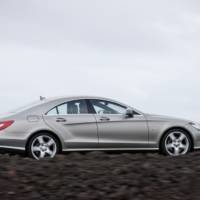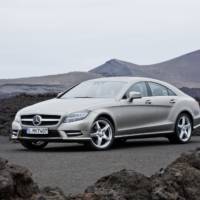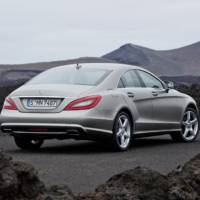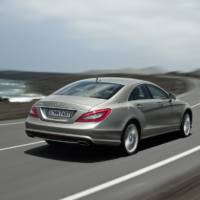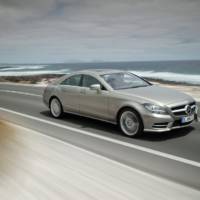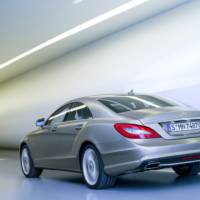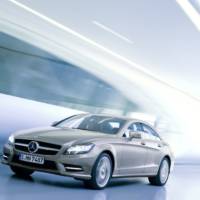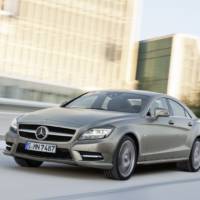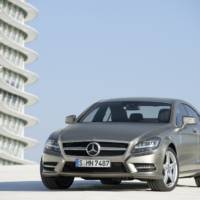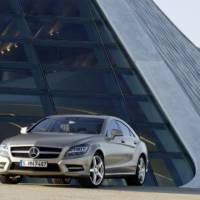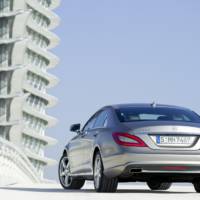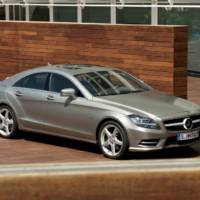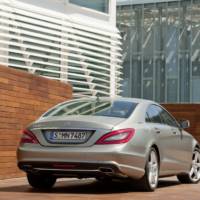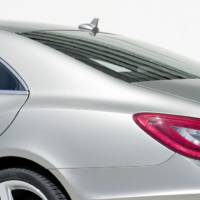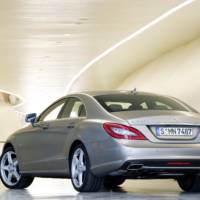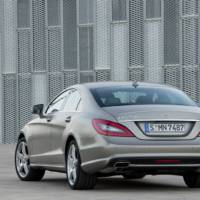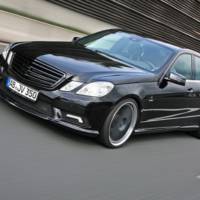The German automaker has announced that the 2011 Mercedes CLS will hit the European market in January 2011, plus it has released new photos and announced the engine lineup for their stylish new four door coupe.
We know that the second generation 2011 Mercedes CLS is 25 percent more efficient when it comes to fuel consumption, and that at launch , the engine choices to be offered will include two 6-cylinder engines : a 265 HP (195 kW)plant for the 350 CDI BlueEFFICIENCY plus a 305 HP (225 kW) unit on the CLS 350 BlueEFFICIENCY.
In March, a 204 HP (150 kW) engine will become available for the 2011 Mercedes CLS while the 408 HP (300 kW) V8 will join the engine range in April, and will be offered on the CLS 500 BlueEFFICIENCY. Both these engines will come mated to the ECO start / stop function as standard.
The most efficient version which will be the 2011 Mercedes CLS 250 CDI BlueEFFICIENCY will need just 5.1-litres of diesel fuel per 100 Km.
Daimler press release :
European market launch in January 2011 – The new CLS: refined sportiness
* More design: a new design language for the second generation
* More efficiency: up to 25 percent lower fuel consumption
* More agility: lightweight construction and new electromechanical power steering
* More visibility: LED High Performance headlamps
* More safety: Active Blind Spot Assist and Active Lane Keeping Assist
A generation ahead: with the CLS, Mercedes-Benz created a new vehicle category in 2003 which for the first time combined the elegance and dynamism of a coupé with the comfort and functionality of a saloon. The customers were delighted, the competition taken aback: for many years the CLS remained the only four-door coupé in its class and since October 2004 it has been the car of choice for some 170,000 buyers around the globe. "Customers all over the world have rewarded us for our courage in launching a completely new vehicle concept onto the market," explains a delighted Dr Joachim Schmidt, Head of Sales & Marketing for Mercedes-Benz. "And with its exciting design and refined sportiness, the new edition of the CLS also benefits from the fact that we are a whole generation ahead of the competition with our four-door Coupé."
The engines: higher output, yet up to 25 percent lower fuel consumption
Efficiency at the highest level: that is what characterises all four engines deployed in the Mercedes-Benz CLS. The output and torque of each engine is greater than in its predecessor; at the same time, fuel consumption has been drastically reduced, by up to 25 percent. Two 6-cylinder models will be available at first at the European market launch in January 2011: the CLS 350 CDI BlueEFFICIENCY with 195 kW (265 hp) and the CLS 350 BlueEFFICIENCY with 225 kW (306 hp) and the ECO start/stop function as standard. Just two months later, the engine range will be expanded to include the CLS 250 CDI BlueEFFICIENCY with 150 kW (204 hp). In the ECE fuel consumption test cycle it requires a mere 5.1 litres of diesel/100 km. The CLS 500 BlueEFFICIENCY, with a V8 engine and 300 kW (408 hp), will follow in April. Both drive variants also have the ECO start/stop function as standard.
Lightweight construction and aerodynamics: important contributions to efficiency
Intelligent lightweight construction plays a decisive role in bridging the classic conflict of objectives between low weight and high strength in the new CLS. The CLS is thus the first vehicle from Mercedes-Benz to have frameless, all-aluminium doors. These are made from deep-drawn aluminium panels with extruded sections, and in comparison with conventional steel doors, are some 24 kilograms lighter. Apart from the doors, the bonnet, front wings, boot lid, parcel shelf, various support profiles and substantial parts of the suspension and engines are all made of aluminium.
Aerodynamics play an important part in the outstanding efficiency of the Mercedes-Benz CLS. Although the new model is wider than its predecessor and thus presents more frontal area to the wind, it was possible to reduce wind resistance by up to ten percent. This is thanks to the Cd value of 0.26, which has been improved by 13 percent.
Electromechanical power steering: a new steering experience
Marrying the ultimate in driving dynamics to the very best in long-distance ride comfort, was the challenge set for the designers and developers of the suspension system for the new Coupé, which aspires to be the epitome of stylish sportiness in both form and function. To achieve this, the suspension system, which had already attracted the highest praise from both the trade press and the public when introduced with the new E-Class, was completely re-tuned and enhanced with a key new component: the electromechanical power steering system makes its world debut in the new CLS. This pioneering innovation makes a new and radical contribution to the relationship between driver, car and road: engineers have, for the first time, been given the freedom to select and to program many of the parameters which influence the steering feel.
In addition, the steering system makes an important contribution to the CLS’ overall efficiency: as the steering support system only uses energy when the vehicle is actually being steered, fuel consumption is cut by up to 0.3 litres/7 g of CO2 compared to the previous model.
For the front suspension, the concept of a three-link front axle design was chosen – just as for the E-Class – and was especially developed for the new CLS. The principle of a lightweight-construction multi-link rear suspension which is attached to a subframe, as used in the new E-Class, was adopted for the CLS as a result of its unsurpassed wheel location qualities. In comparison to its predecessor, all the components have been modified to give both greater comfort and better driving dynamics.
LED High Performance headlamps: greater visibility and full functionality
The CLS is the first passenger car in the world to offer LED High Performance headlamps, which combine the exciting colour elements of LED technology – similar to those of daytime running lamps – with the performance, functionality and energy efficiency of today’s bi-xenon generation (as an optional extra). This new light system provides, for the first time ever, the Intelligent Light System already proven in Mercedes models fitted with bi-xenon headlamps in combination with LED technology. The headlamps, with their 71 LED lamps in total, look exciting; and they serve to underline the unmistakable appearance of the CLS. The light specialists from Mercedes-Benz have for the first time been able to use LED technology in the admired and innovative Adaptive Highbeam Assist, resulting in an entirely new level of safety for night-time driving.
In contrast to the first vehicles equipped with LED headlamps, no compromises are now necessary with respect to the functionality and performance of the lighting technology. There are further arguments for the LED-based lighting technology: the average operating life of an LED is around 10,000 hours, around five times longer than that of a xenon light; moreover, LED headlamps most closely approximate to the colour of daylight. This means that LED light is in keeping with the normal human perception patterns and that the driver experiences significantly more brightness on the road at night. Studies have shown that the closer the colour of artificial light comes to daylight, the less the strain on the eyes. With a colour temperature of 5500 kelvin, LED light is closer to daylight (6500 K) than xenon light (4200 K).
New driving assistance systems: greater safety
More than a dozen driving assistance systems on the new CLS help to prevent traffic accidents and reduce the severity of an accident. The Active Blind Spot Assist and the Active Lane Keeping Assist are new.
Active Blind Spot Assist warns the driver if – with the assistance of short-range radar sensors – it detects that there is a danger of collision if the vehicle is about to change lanes. Should the driver ignore the warnings and the vehicle come dangerously close to the next lane, Active Blind Spot Assist will intervene. By applying braking force to the wheels on the opposite side of the vehicle via the Electronic Stability Program ESP®, a yaw movement is created which counteracts the collision course.
Active Lane Keeping Assist is now also linked to ESP® for the first time. This system kicks into action if the Mercedes vehicle inadvertently drifts over a solid line to the right or left of a lane. In this case, Active Lane Keeping Assist uses the ESP® to gently brake the wheels on the far side and thereby bring the vehicle back on course. A display on the instrument cluster warns the driver at the same time. If broken lane markings are crossed, the system controls an electric pulse generator in the steering wheel which generates vibrations for a short time – a discreet but highly effective cue to countersteer immediately. Before the braking system intervenes, the steering wheel always vibrates to provide a warning.
The exterior: classic Coupé styling with distinctive front
The new CLS continues with the pioneering role of its predecessor and at the same time shows itself to be a brand-new star on the scene. What immediately strikes the eye is the innovative front design, which is reminiscent of the Mercedes-Benz SLS AMG. Visually, the radiator grille is not integrated into the bonnet but is formed separately. This highlights the long, sporty bonnet even further. The grille is dominated by the large central star, which underlines the car’s relationship to the other coupés of the brand and strengthens the brand identity.
The typical CLS outline, with its elegantly long proportions, is the dominating attribute of the new model. The effect of the dynamic, athletic form has been enhanced with a new interplay of lines and areas. The front edge of the structure above the wings slopes off towards the rear. This novel design feature, called the dropping line by designers, represents a new interpretation of a formal design element harking back to the uniquely rich wealth of forms present in historic Mercedes sports cars.
A distinctive and muscular sports car-like shoulder line above the rear axle highlights the athletic character of the new CLS. The flared wheel arches resemble the powerful thighs of a feline predator waiting to pounce.
The interior: design brings quality to life
The interior of the CLS is also distinguished by a timeless design which combines straightforward elegance with innovative details and handcrafted perfection. An eye-catching feature is the wrap-around effect of the cockpit: a high line sweeps from the driver’s door over the instrument panel support and across to the front passenger door. The central display has also been integrated harmoniously into the upper part of the instrument panel. At the same time, the downward sweeping side line on the doors continues the dynamic dropping line of the exterior.
As a design trendsetter, the CLS sets new standards in interiors with its wide variety of individualisation options. Five interior colours, five trim designs and also three qualities of leather are available to choose from.
The CLS lives up to its role as a design icon through the innovative material finishes used. An example of this is the exciting interplay of satin-finish and shiny metallic surfaces. The CLS also exudes refined sportiness with its lavish and high-class trim elements which can be found on the instrument panel support, the centre console and parts of the door trim. The customers can choose between three exclusive wood types: high-gloss brown burr walnut, high-gloss black ash and satin-finish light-brown poplar. The interior is given an even more progressive look with the addition of piano lacquer or AMG carbon fibre trim elements.
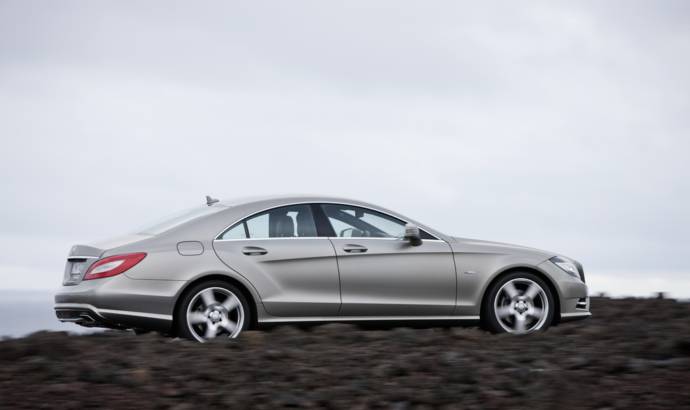
04 Oct 2010
0

